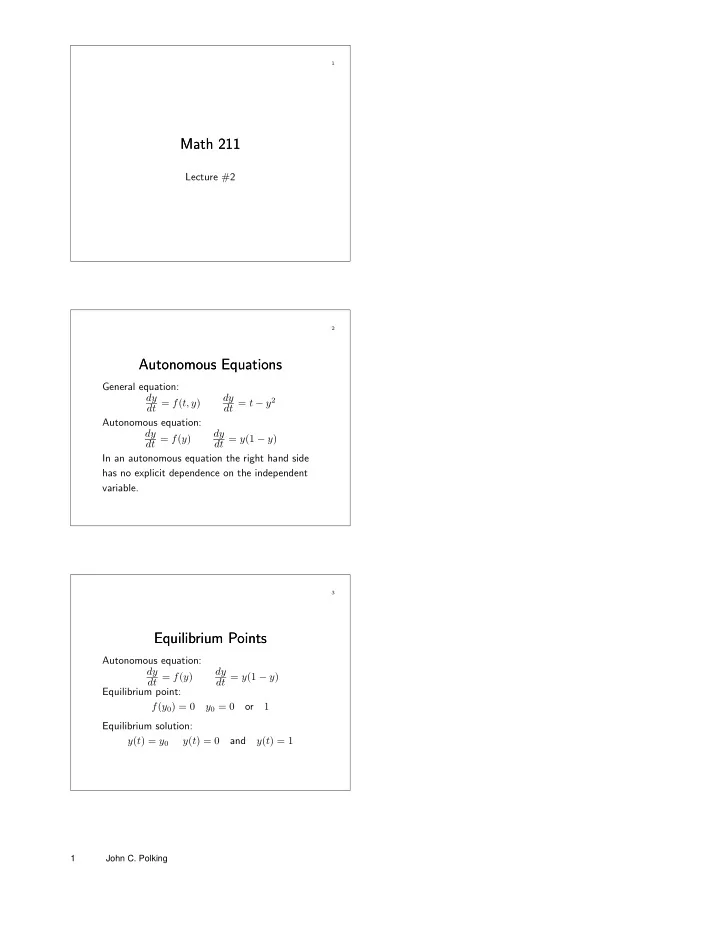

1 Math 211 Math 211 Lecture #2 2 Autonomous Equations Autonomous Equations General equation: dy dy dt = t − y 2 dt = f ( t, y ) Autonomous equation: dy dy dt = f ( y ) dt = y (1 − y ) In an autonomous equation the right hand side has no explicit dependence on the independent variable. 3 Equilibrium Points Equilibrium Points Autonomous equation: dy dy dt = f ( y ) dt = y (1 − y ) Equilibrium point: f ( y 0 ) = 0 y 0 = 0 or 1 Equilibrium solution: y ( t ) = y 0 y ( t ) = 0 y ( t ) = 1 and 1 John C. Polking
4 Between Equilibrium Points Between Equilibrium Points dy dt = f ( y ) > 0 ⇒ y ( t ) is increasing. dy dt = f ( y ) < 0 ⇒ y ( t ) is decreasing. 5 Separable Equations Separable Equations General equation: dy dy dt = t − y 2 dt = f ( t, y ) Separable equation: dy dy dt = g ( y ) h ( t ) dt = t sec y In a separable equation the right hand side is a product of a function of the independent variable ( t ) and the unknown function ( y ) . 6 Solving Separable Equations Solving Separable Equations dy dt = t sec y Separate the variables: dy sec y = t dt or cos y dy = t dt We have to worry about dividing by 0, but sec y is never equal to 0. 2 John C. Polking
7 Integrate both sides: � � cos y dy = t dt − sin( y ) + C 1 = 1 2 t 2 + C 2 or sin( y ) = − 1 2 t 2 + C where C = C 1 − C 2 . 8 sin( y ) = − 1 2 t 2 + C Solve for y . � C − 1 � 2 t 2 y ( t ) = arcsin . This is the general solution to dy dt = t sec y . 9 Solving Separable Equations Solving Separable Equations The three step process to solve dy dt = g ( y ) h ( t ) dy • Separate the variables. g ( y ) = h ( t ) dt � � dy • Integrate both sides. g ( y ) = h ( t ) dt • Solve for y . 3 John C. Polking
10 Examples Examples • y ′ = ry • R ′ = sin t with R (0) = 1 , − 2 , − 1 1 + R 3 t 2 x • x ′ = with x (0) = 1 , 0 1 + 2 x 2 • y ′ = 1 + y 2 with y (0) = − 1 , 0 , 1 11 Why It Works Why It Works dy dt = g ( y ) h ( t ) 1 dy dt = h ( t ) if g ( y ) � = 0 g ( y ) � � dy 1 dt dt = h ( t ) dt g ( y ) � � 1 g ( y ) dy = h ( t ) dt 4 John C. Polking
Recommend
More recommend